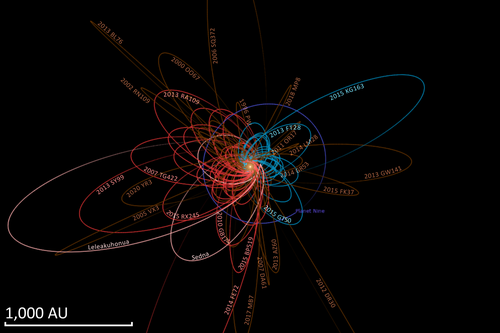474640 Alicanto
| Discovery Perihelion | 47.289 AU | |
|---|---|---|
| 328 AU (barycentric)[5] 332.80 AU | ||
| Eccentricity | 0.8579 | |
| 5900 yr (barycentric)[5] 6071 yr (2,217,590 d) | ||
| 0.6822° | ||
| 0° 0m 0.72s / day | ||
| Inclination | 25.572° | |
| 65.996° | ||
| 326.72° | ||
| Physical characteristics | ||
Mean diameter | ||
| 0.04 (est.)[6] | ||
| 23.3[10] | ||
| 6.5[1][3] | ||
474640 Alicanto (
Discovery and orbit

Alicanto was discovered by American astronomer
With an
Naming
On 14 May 2021, the object was named by the
Physical characteristics
Alicanto has an absolute magnitude of 6.5 which gives a characteristic diameter of 130 to 300 km for an assumed albedo in the range 0.25–0.05.[7]
Michael Brown's website lists it as a possible dwarf planet with a diameter of 314 kilometres (195 mi) based on an assumed albedo of 0.04.[6] The albedo is expected to be low because the object has a blue (neutral) color.[6] However, if the albedo is higher, the object could easily be half that size.
Alicanto's visible spectrum is very different from that of 90377 Sedna.[9][13] The value of its spectral slope suggests that the surface of this object can have pure methane ices (like in the case of Pluto) and highly processed carbons, including some amorphous silicates.[9] Its spectral slope is similar to that of 2013 RF98.[9]
Relevance to the Planet Nine Hypothesis
This minor planet is one of a number of objects discovered in the Solar System to have a
Comparison

See also
References
- ^ a b c d e f g "(474640) Alicanto". Minor Planet Center. Retrieved 18 May 2021.
- ^ a b c "WGSBN Bulletin Archive". Working Group for Small Bodies Nomenclature. 14 May 2021. Retrieved 16 May 2021. (Bulletin #1)
- ^ a b c d e f g h "JPL Small-Body Database Browser: 474640 (2004 VN112)" (2016-09-03 last obs.). Jet Propulsion Laboratory. Retrieved 18 May 2021.
- ^ Marc W. Buie (8 November 2007). "Orbit Fit and Astrometric record for 04VN112". SwRI (Space Science Department). Archived from the originalon 18 August 2010. Retrieved 17 July 2008.
- ^ a b c Horizons output. "Barycentric Osculating Orbital Elements for 2004 VN112". Retrieved 20 September 2021. (Ephemeris Type:Elements and Center:@0)
- ^ a b c d e Michael E. Brown. "How many dwarf planets are there in the outer solar system? (updates daily)". California Institute of Technology. Retrieved 18 September 2016.
- ^ a b "Asteroid Size Estimator". CNEOS NASA/JPL. Retrieved 12 November 2017.
- ^ a b c d "LCDB Data for (474640) Alicanto". Asteroid Lightcurve Database (LCDB). Retrieved 18 May 2021.
- ^ S2CID 119419889.
- ^ a b "AstDyS 2004 VN112 Ephemerides". Department of Mathematics, University of Pisa, Italy. Retrieved 28 March 2014.
- ^ Discovery MPEC
- S2CID 118890903.
- ^ "JPL Small-Body Database Browser: 90377 Sedna (2003 VB12)". Retrieved 28 March 2014.
- JPL Solar System Dynamics. Retrieved 9 April 2014.
